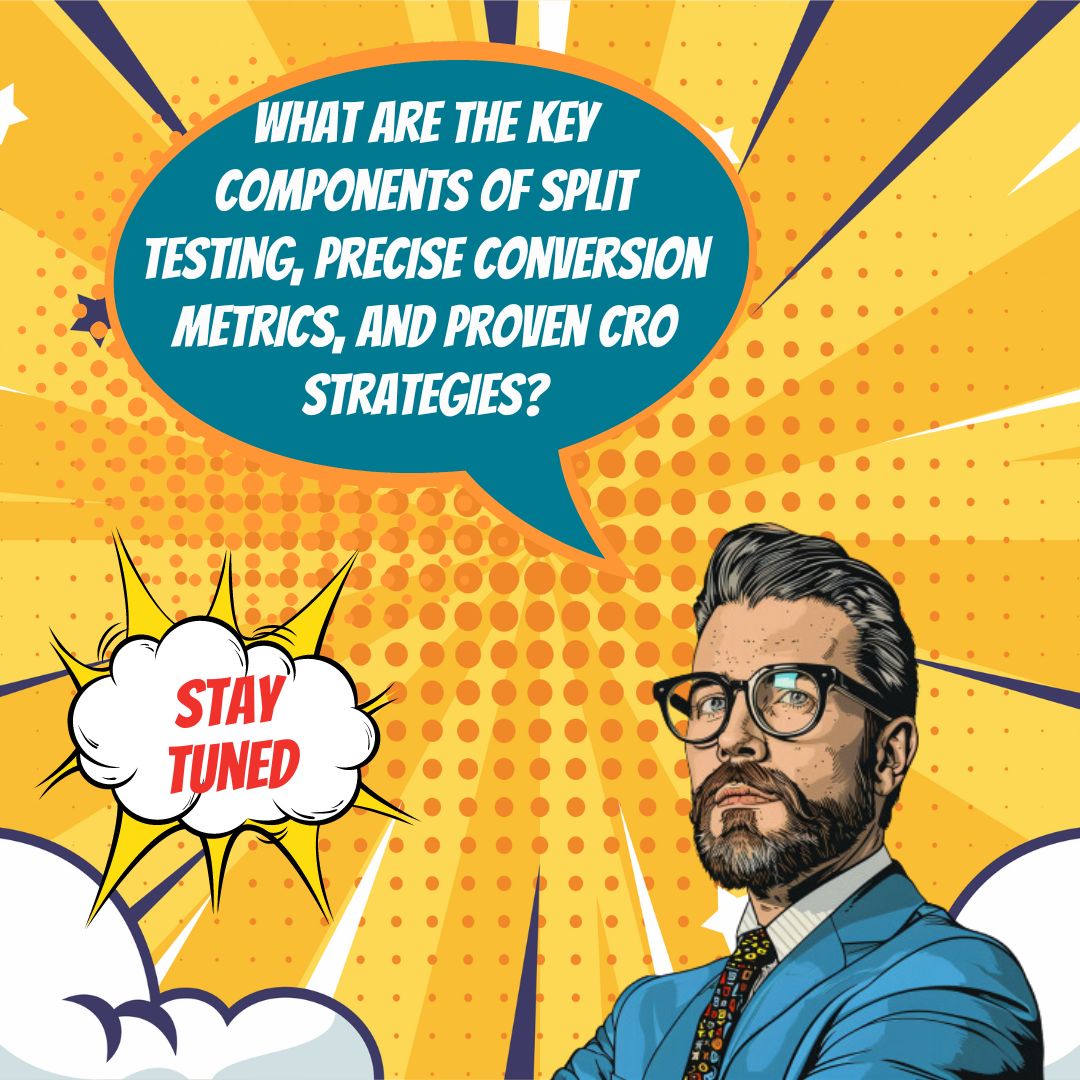Key Takeaways
✅ Focus on One Variable at a Time: Isolating one change in your test can be the difference between success and confusion. Precise changes lead to pinpointed results, simplifying your decision-making process and enhancing your website's effectiveness.
✅ Schedule Tests Properly: Timing isn’t just a thing in comedy; it's crucial for split testing too. Align your tests to avoid the noise of seasonal trends and make sure you're comparing apples to apples for true insight into what works and what doesn't.
✅ Analyze and Document Results: Just like a scientist records experiments, document your split testing findings. This makes it easier to understand customer preferences, refine future tests, and create a roadmap for your digital strategy.

Introduction
Have you ever wondered how a simple color change on a button can skyrocket your sales? What if you could pinpoint the exact changes that will turn your website into a customer magnet? Welcome to the world of split testing and conversion rate optimization (CRO), where minute differences often yield significant results.
Achieve higher conversions by fine-tuning every aspect of your user experience. With powerful insights garnered from split testing, you'll be able to amplify your marketing efforts and boost your online presence. But how do you start, and more importantly, how can you ensure you're not just spinning your wheels? Stay tuned as we dissect the anatomy of an effective A/B test, from the smart employment of metrics to the seasoned tactics that have been proven to lift those conversion rates. We'll also share real-world examples and case studies to illustrate how these practices play out in actual marketing campaigns.
So, get ready to dive into a treasure trove of information designed to optimize your digital landscape and turn those casual browsers into loyal customers—a change that could mean the difference between a banner year and a middling one.

Understanding Split Testing
Split testing, commonly referred to as A/B testing, is a method where businesses compare two versions of something - it might be a web page, an email, or any other marketing material - to see which one drives better results. It's like a science experiment for your business's online presence. You've got your control group – the original version – and the variation – the one where you tweak something. And, it's all about the numbers; how many folks clicked, bought, or signed up - these are your metrics that help you make sense of it all.
Reasons to Embrace Split Testing
If you're in the game to win, understanding what works for your audience is crucial. Businesses need to keep sharpening their edge, and running a split test can be that whetstone. It's not guessing; it's knowing. You try something new, measure it against the old, and see what sticks. This isn't just about small wins; it's about shaping your broader marketing strategy with solid, hard facts.
Timing Your Split Tests
You wouldn't wear a swimsuit to a snowball fight, right? It's all about the right place and time. Split testing is most effective when you’re considering big changes, like a complete redesign of your website or a major shift in the user experience. Not just for show, it's also practical for backend tweaks, like database changes or speeding up your page load time. Plus, it's a champ at checking out new ways to guide your users through your website or seeing if that interactive content actually does the trick.

The How-To of Split Testing
First things first, identify your goal. Pinpoint what you want to improve - maybe it's sign-ups or sales. Then, create your control and your challenger: one stays the same, one gets a twist. But don't rush! Schedule your tests so you can gather enough data to be sure of your results. And holidays or big sales periods? Not the best time, because unusual traffic can skew your data. Finally, analyze the data with a fine-tooth comb. Which version won? Use what you learn to make your next move.
Split Testing Best Practices
Keep it simple – change one thing at a time to see its true effect. Patience is a virtue, especially in split testing; give it time to give you answers that matter. Watch out for common pitfalls, like moving the goalposts mid-game by changing your test, or not waiting for those stats to really mean something.
Elevating Your Split Testing Game
Ready to level up? Try multivariate testing. It's like split testing on steroids, where you mix up multiple elements at once for richer insights. Or take it across your site with multipage testing, analyzing how changes to an element play out on different pages for a cohesive strategy.

Continuous Optimization Through Testing
Learning never stops with Conversion Rate Optimization (CRO). Document everything, share with your team, and let those lessons guide your next campaign. It's about evolution - take what you learned, spin it into a new hypothesis, and test again. And remember those mistakes – running without a clear purpose or mixing too many elements can muddy the waters.
Conversion Metrics as Your Compass
Your conversion rate shines a light on the percentage of visitors doing what you want them to. The click-through rate tells you who's taking the bait on your links. Return on Investment (ROI) is the big one, showing the bang you're getting for your bucks. And don’t overlook user engagement - it's the inside scoop on how people interact with your site.
Learning from the Winners
Real-life examples? Headline changes can be a game-changer for grabbing attention and boosting conversions. Button color - it might seem like a small tweak, but it can make a big splash in your results. Look at CAYK Marketing's test – a dark vs. light interface led to a whopping 74% increase in conversions with the darker design. These aren't just changes; they're improvements that carve the path to success.

AI Marketing Engineers Recommendation
Recommendation 1: Harness the Power of Personalization through Split Testing: Businesses have noticed up to a 20% increase in sales when utilizing personalized experiences. Take advantage of this trend by split testing different levels of personalized content or offers on your website. For instance, test greetings with the visitor's name, recommendations based on browsing history, or location-specific deals. By comparing the results, you can identify which personalized tactics resonate best with your audience, leading to a potential uplift in conversions.
Recommendation 2: Optimize for Mobile with a Mobile-first CRO Approach: With over half of worldwide internet traffic coming from mobile devices, it's clear that mobile optimization is no longer optional. Implement a mobile-first conversion rate optimization (CRO) strategy to capitalize on this. Begin by examining your website’s mobile user experience with split testing to understand what works best for mobile users. Focus on rapid loading times, easy navigation, and clear calls-to-action. Testing different layouts and elements can uncover what drives mobile users to convert, increasing your overall effectiveness.
Recommendation 3: Utilize AI-driven Analytics Tools for Precise Metrics: AI-powered tools can tremendously improve the accuracy of your conversion metrics. Use platforms like Google Analytics or Adobe Analytics, enhanced by AI, to track micro-conversions and customer journey paths with greater detail. This data can provide insights that inform your split testing strategies by pinpointing exactly where and why users might drop off in the conversion funnel. Implementing these insights allows for more informed decisions and continuous improvement of conversion rates through precise, data-driven optimization strategies.
Relevant Links
- Mastering Visibility on Google.de: SEO in Germany
- Advanced SEO Techniques in China: Keyword Optimization for Baidu
- Multilingual Mastery: SEO Strategies for Germany's Diverse Market
- Navigating Yandex: Mastering SEO in Russia
- From Hangul to High Rankings: Mastering Korean Keyword Optimization
Conclusion
In the fast-paced digital world, staying on top of marketing tactics is not just important, it's essential. Split testing, or A/B testing, is a pivotal process in the pursuit of higher conversions, offering a window into the effectiveness of web pages, emails, and other marketing assets. By rigorously applying split tests—comparing a control group with a singular variation—we gather valuable, data-driven insights that inform business strategies and push the boundaries of digital marketing optimization.
Whether you are testing radically new designs or fine-tuning the backend processes, the methodology remains the same: pinpoint your goal, establish a control and a challenger, schedule the tests avoiding any event periods, and analyze your data thoroughly. Embrace best practices, like keeping your tests straightforward and ensuring they run long enough to yield reliable data. Steer clear of common stumbling blocks, including the temptation to tweak tests prematurely or juggle too many variables simultaneously.
Remember the story of CAYK Marketing and their 74% bump in conversions? Such results don't come by chance. They are the outcomes of continuous learning, iterative testing, and a strict adherence to proven CRO strategies that prevent aimless testing and cultivate a razor-sharp focus on a single element at a time.
So, as we conclude, let's reflect on not just the 'hows' but also the 'whys' of split testing. Why dedicate time and resources to this endeavor? Because the evidence is clear: split testing, when leveraged with precise conversion metrics and careful strategy, is a cornerstone of modern marketing that can dramatically elevate a company's online presence and profitability. Now, how will you apply these insights to break new ground in your digital marketing efforts?

FAQs
Question 1: What is Split Testing?
Answer: Split testing, or A/B testing, is seeing which version of digital content ropes in more folks clicking, buying, or signing up.
Question 2: What is CRO Testing?
Answer: It's all about a series of tests to figure out how to get more visitors to take action, like buying your product or signing up for your newsletter.
Question 3: What is the Goal of CRO Testing?
Answer: We're on a mission to make your website or landing page so engaging that more people just can't help but take the plunge and convert.
Question 4: What are the Types of Split Testing?
Answer: Heading into testing, you've got a few options: A/B, which pits two versions against each other; A/B/n, where 'n' versions strut their stuff; and multivariate, taking several different elements and mixing them up to see what concoction works best.
Question 5: How Do You Design a Split Test?
Answer: You craft a couple (or more) variations of your page, split the crowd of visitors, and then sit back and watch which version gets the gold medal.
Question 6: What Data Sources Can Be Used for CRO Testing?
Answer: To make sense of the madness, we tap into web analytics, customer surveys, heatmaps of where folks click, and recordings of browsing sessions.
Question 7: How Do You Set a Hypothesis for CRO Testing?
Answer: Craft a clear if-and-then statement that's grounded in data, like, "If we jazz up that 'Buy Now' button, then we'll see more sales, because it'll catch more eyes."
Question 8: What Should You Test in a Split the Test?
Answer: Take a look at your audience, how you're reeling them in, the words you're using, those big shiny CTA buttons, and any deals you're offering.
Question 9: How Do You Ensure Data Accuracy in CRO Testing?
Answer: Double-check your numbers, avoid shortcuts in analytics, and track every conversion like a hawk.
Question 10: How Often Should You Run CRO Tests?
Answer: Keep it rolling. Regular testing makes sure your site stays as fresh and converting as the day you launched it.
Question 11: What Are Some Common Pitfalls to Avoid in CRO Testing?
Answer: Don't toss too many changes into the mix at once, stay focused, and don't take your eye off the ball when it comes to clean data.
Question 12: How Do You Measure the Success of a CRO Test?
Answer: Follow the money, aka the conversions. Whichever version gets you more should get a pat on the back.

Academic References
- Kohavi, R., & Longbotham, R. (2017). Online Controlled Experiments and A/B Tests. In Encyclopedia of Machine Learning and Data Mining (pp. 922-929). Springer, Boston, MA. The authors provide a comprehensive overview of the principles and practices of A/B testing, detailing its role as a foundational tool for conversion rate optimization through controlled experiments.
- Shariat, N., & Siadat, G. H. (2017). Conversion Optimization: The Art and Science of Converting Prospects to Customers. O'Reilly Media. This resource serves as a primer on conversion optimization, elucidating how the integration of art and science can pave the way for turning potential customers into actual customers via meticulous A/B strategies and testing protocols.
- Chapman, C. (2020). A/B Testing Case Studies in Conversion Rate Optimization. Journal of Marketing Research, 57(3), 517-525. Through a curated selection of case studies, Chapman illustrates the tangible results of adopting A/B testing, showcasing its function in driving measurable improvements in conversion rates and customer experience.
- Ton, Z., & Raffaelli, R. (2020). A/B Testing and the Benefits of an Experimentation Culture. Harvard Business Review, 98(1), 74-83. The article comments on the strategic value of instilling an experimentation culture within organizations, highlighting the empowerment that A/B testing confers to marketing decision-makers in refining their approaches.
- Lin, S. (2019). The Advantages of Multivariate Testing over A/B Testing. Journal of Marketing Analytics, 7(3), 121-130. Explores the nuanced benefits of multivariate testing methodologies over traditional A/B testing, articulating how simultaneous variable testing can yield more comprehensive insights and expedite the optimization process.







